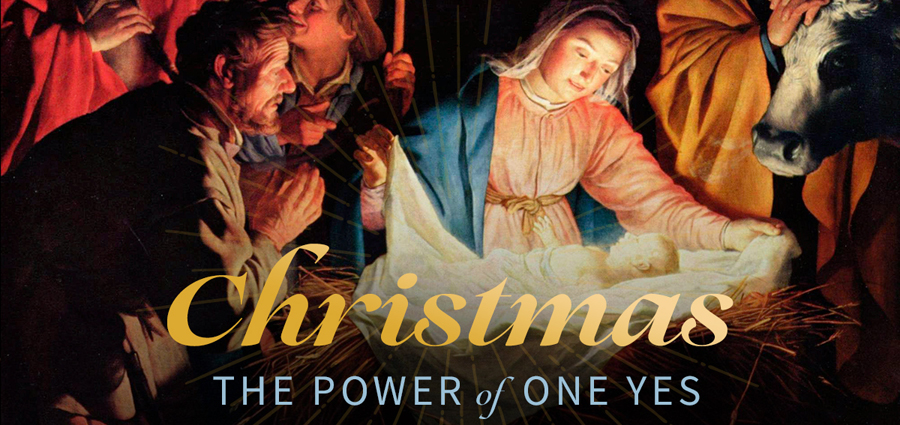
By: Nicole O'Leary on December 27th, 2020
Sheltered Between Two Hearts
Despite the saccharine depictions of the Nativity found on so many greeting cards and coffee mugs, there is nothing sentimental about the accounts of Jesus’ birth put forward in the Gospels. There is, however, much that God wishes to communicate to us about Himself through the words of the inspired authors.
Saint Luke relates:
“And [the shepherds] went with haste, and found Mary and Joseph, and the babe lying in a manger,” (Luke 2:16).
The cave, damp and reeking of its animal inhabitants, is a terrible place to give birth—even by first-century standards. The Child’s parents have made a tedious journey and find themselves on the outskirts of a strange town, vulnerable to roving bands of thieves and to the unpredictability of the elements.
What can we glean from this humble scene about the identity of the Word-Made-Flesh? First, that He is no stranger to poverty and want; that His desire to identify Himself with His creatures impels Him not only to come into the world in the weakness and helplessness of infancy, but in circumstances appalling to our contemporary sensitivities. For this reason, over the centuries, contemplation of the crèche has offered weary hearts insight into the unfathomable condescension of God. Among those who know themselves to be poor, the poverty of the God-Man is a refuge which inspires hymns of praise and thanksgiving.
There is, however, something else: in choosing to be born in poverty and the perilous uncertainty of the ancient world, God offers us a catechesis on family life that is particularly relevant to the modern reader.
The message is simple: marriage matters. Jesus entered the world in the most adverse conditions, but He nevertheless chose to have a mother and a father. He contented Himself to lay His head in a feeding trough, but He found true shelter between the two hearts which received Him. It is preposterous to suppose that Mary and Joseph—who were truly spouses, despite the unique circumstances of their marriage—did not exchange their own look of love as they gazed in adoration at the Christ-Child. Imagine how the love between those two spouses—one, the Immaculate Conception; the other, her God-given guardian and the foster-father of her Son—must have warmed the damp cave.
 Today, it is increasingly the case that the vows expressed in marriage are implicitly—if not even explicitly—understood as non-binding. Lifelong marriage is viewed as an unrealistic ideal, when in fact it is not only the spouses’ obligation but a source happiness and peace. The upward calling of faithful, self-sacrificing love is rarely proclaimed, and convenience and pleasure too often determine whether or not a marriage lasts. Frequently, children are expected to accept the instability of their parents’ various relationships, and parents are believed to have fulfilled their obligation as primary educators as long as the children are cultured and employable. Education in moral virtue is, at best, an afterthought.
Today, it is increasingly the case that the vows expressed in marriage are implicitly—if not even explicitly—understood as non-binding. Lifelong marriage is viewed as an unrealistic ideal, when in fact it is not only the spouses’ obligation but a source happiness and peace. The upward calling of faithful, self-sacrificing love is rarely proclaimed, and convenience and pleasure too often determine whether or not a marriage lasts. Frequently, children are expected to accept the instability of their parents’ various relationships, and parents are believed to have fulfilled their obligation as primary educators as long as the children are cultured and employable. Education in moral virtue is, at best, an afterthought.
Contemplating the little family in the cave of Bethlehem, an alternative to the contemporary narrative emerges. By choosing to be born into a family, God teaches us that what matters in the formation and development of children—more than any external factors—is that parents offer their children an example of faithful love. Furthermore, for the children, this love is not simply a model to be imitated, but a true place of refuge. Even when the external structures of life are poor, simple, and homely, the two hearts—the hearts of Dad and Mom, of husband and wife—offer a stable shelter.
It matters little, God shows us, that children are provided with the latest technologies, that their parents cart them from one extracurricular activity to another, or even that they have every possible opportunity for academic enrichment at their fingertips. What matters is that the children can look to the love between their father and mother as a permanent and reliable place of refuge.
In the Holy Family, God teaches us that He desires family life to be a school of love. By introducing us to the world through the family, He wishes to teach us how to love and He lays the foundation for us to become spouses and parents ourselves. In this school, we will develop the emotional and psychological maturity necessary to commit ourselves in love. Finally, in the family, God desires to reveal something of His identity to us. “God Himself is an eternal exchange of love, Father, Son, and Holy Spirit,” the Catechism of the Catholic Church explains, “and He has destined us to share in that exchange,” (CCC 221). Thus, the tender and faithful communion of love found in family life should offer a window—albeit imperfect—into the unconditional love of God.
Children, you are meant to find shelter between the hearts of your parents. Spouses, the love you share with each other is meant to be filled with warmth and generosity so that your children can become life-giving lovers themselves. This is God’s desire for each of us—and how beautiful it is!
And if we have experienced the brokenness that is so commonplace in families today, God has provided a solution that is arguably even more wonderful: a refuge between His own Heart and the Immaculate Heart of His Mother. No matter the circumstances of our lives, these will be our eternal refuge and the source of our lasting joy.
